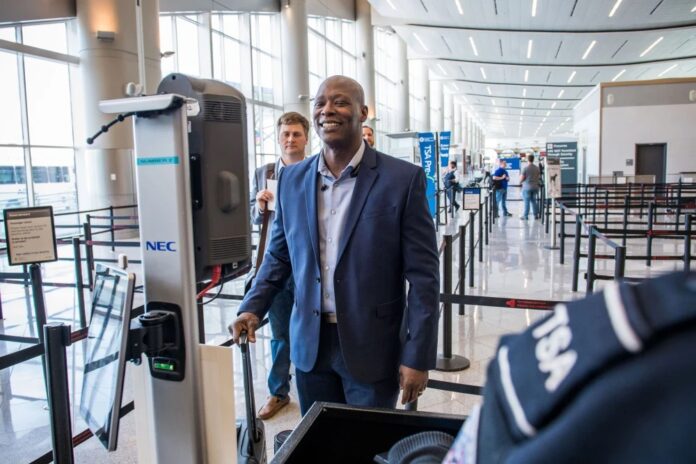Illustrative Image: Airport Biometric Service Market: Transforming Airport Services into Smoother and Better Operations
Image Source & Credit: NBCNews
Ownership and Usage Policy
The global air travel is expected to reach nearly 8 billion passengers a year by 2040, which consequently puts huge pressure on airports, airlines, and border authorities. The industry is continuously fighting against factors like limited space, workforce shortages, and outdated systems that were never designed for such acceleration. To address these hurdles, many operators are turning to biometric solutions, which are rapidly changing how passenger identity is managed in airports across the world. Unlike traditional ID checks, biometric tools bring a mix of stronger security, smoother operations, and faster passenger flow. The 2024 IATA Global Passenger Survey showed this shift is well underway, with almost half of travelers, i.e., around 46% already using biometric processes during their airport journey in 2024.
Let’s examine how the biometric services in airports are changing the ID verification techniques, making the operation faster, smoother, and well-managed.
Why Airport Biometric Service is Turning to be A Billion-Dollar Market?
Biometric screening is transforming the whole process of identification in the recent aviation world. Here are a few instigators that are directly driving the demand for airport biometric services.
- Passenger Demand: Air passengers are increasingly lured by the fact that they don’t have to carry all their credentials every time. Biometric services make their work less hectic and faster. Thus, the huge popularity increases its adoption, like the Customs and Border Protection’s (CBP) facial-recognition system now operates at roughly 238 airports in the U.S. Moreover, it has plans to extend deployment to over 400 locations. Again, Singapore’s Immigration & Checkpoints Authority has enabled passport-free entry using facial and iris biometrics across all terminals at Changi Airport in 2024. These developments indicate how biometric technology is fast becoming essential to meeting rising traveler expectations and operational efficiency.
- Regulatory Norms and Border Control Modernization: To streamline travel and to relieve travelers, regulatory bodies are releasing newer norms. The CBP in the U.S. is mandating a biometric entry-exit system through norms, namely, the Intelligence Reform and Terrorism Prevention Act. Under these laws, already over 55 million travelers have been processed via facial recognition and anti-impersonation checks. This initiative is even supported by the Department of Homeland Security with digital identity pilots and AI-enhanced cloud services to fast-track traveler verification. Another instance is Singapore’s Changi Airport is targeting more than 95% automated immigration by 2026. Other than this, India’s Digi Yatra offers paperless, facial recognition-based airport access across major hubs, while Australia trials contactless clearance targeting passport-free entry by 2030.
- A Cost-Efficient Option for Operators: Biometric airports reduce the burden through automation, efficient staffing, and infrastructure modification. The Philippines’ eGate initiative is a program initiated by the government to reduce operational timing and cost. It has reduced processing time by around 30 seconds per passenger, and it has saved operational and labor expenses to a great extent. These advancements are increasing the demand for airport biometrics.
These are a few primary instigators of the market, while there is a pool of reasons behind the airport biometric service’s expansion. Innovations in airport biometrics are continuously enhancing air travelers’ travel experience. Now, let’s check out what innovations are taking place recently that support improving the whole air travel experience.
What Major Innovations Are Happening in the Field of Airport Biometric Service?
From the moment passengers check in until they board their flight, there is a growing expectation for faster and safer processes. Biometric tools are stepping in to meet this demand, changing the way identity is confirmed at every stage. In fact, in a survey, it is found that nearly three out of four passengers feel biometrics is much convenient than having a boarding pass. Here are some major innovations that are changing the way people will travel in the future.
- The U.S., for example developing TSA and CLEAR piloted biometric “eGates” which contain real-time facial recognition. This system was deployed in major airports such as Atlanta, Washington D.C., and Seattle in August 2025.
- An AI-driven immigration corridor that provides document-free passage in seconds in launched in Dubai in August 2025 as well.
- The DigiYatra airport biometric program started in India, is now live across over 24 airports, has logged nearly 60 million biometric-enabled journeys, and surpassed over 15 million app downloads.
It is projected that in the coming years the demand for the biometric facilitation will increase from roughly 47% to more than 76% of total annual revenues as more airports and airlines’ modernization plans like this will advent. Passengers are becoming comfortable with using biometrics in their daily lives, and it has the advantage of freeing up resources to use in places in need.
Wrapping Up – The Future Will Notice a Tide of Airport Biometric Services
Airport biometric services are at the heart of the next aviation transformation. They provide great efficiency in work and in efficiently managing passengers. For operators and technology providers, it’s a great opportunity, ranging from end-to-end passenger identity management to retail-linked personalization.
Source: https://www.researchnester.com/reports/airport-biometric-service-market/7378













 The African Research (AR) Index is a comprehensive scholarly directory and database focused explicitly on journal publishers that publish and disseminate African research.
The African Research (AR) Index is a comprehensive scholarly directory and database focused explicitly on journal publishers that publish and disseminate African research.

